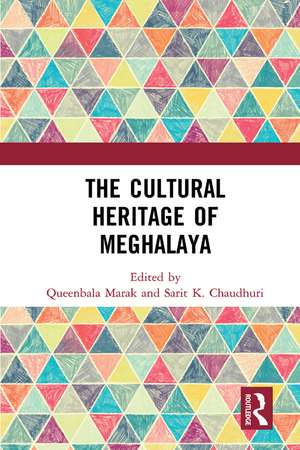The Cultural Heritage of Meghalaya
Editat de Queenbala Marak, Sarit K. Chaudhurien Limba Engleză Hardback – 31 mar 2020
This book looks at the state of Meghalaya exhaustively from the perspective of heritage documentation and maintenance. The 38 chapters written by anthropologists and independent researchers, present the rich traditions found in the region. This volume will be of great help to academicians, researchers, students, and laymen interested in a comprehensive study of the region.
Please note: This title is co-published with Manohar Publishers, New Delhi. Taylor & Francis does not sell or distribute the Hardback in South Asia.
Preț: 895.29 lei
Preț vechi: 1189.69 lei
-25% Nou
Puncte Express: 1343
Preț estimativ în valută:
171.43€ • 176.84$ • 142.08£
171.43€ • 176.84$ • 142.08£
Carte tipărită la comandă
Livrare economică 20 februarie-06 martie
Preluare comenzi: 021 569.72.76
Specificații
ISBN-13: 9780367499600
ISBN-10: 0367499606
Pagini: 752
Ilustrații: 104
Dimensiuni: 138 x 216 mm
Greutate: 1.55 kg
Ediția:1
Editura: Manohar
Colecția Routledge
ISBN-10: 0367499606
Pagini: 752
Ilustrații: 104
Dimensiuni: 138 x 216 mm
Greutate: 1.55 kg
Ediția:1
Editura: Manohar
Colecția Routledge
Public țintă
PostgraduateCuprins
PART I: ARCHAIC PEOPLE AND POSSESSIONS 1. Early Settlers of Meghalaya: An Anthropo- Archaeological Perspective 2. Prehistoric Tool-making in Garo Hills 3. History Etched in Stone: A Study of the Khasi-Jaintia Megalithic Tradition 4. Socio-Cultural Analysis of Megaliths in Jaintia Hills 5. Peopling of Shillong Plateau: A Molecular Anthropological Insight
PART II: PEOPLE AND SOCIETY 6. Revisiting the Oral: Controlling Mechanisms in a Non-Monetized and Non-Hierarchical Society 7. Matriliny of the Garos with Special Reference to Women’s Status 8. Nepalis of Meghalaya: Settlement, Social Institutions and Festivals 9. Socio-Cultural Aspects of the Hajongs of Meghalaya 10. Touching the Intangibles: Revisiting Kinship among the Sakachep
PART III: LANGUAGE AND CULTURE 11. New Perspectives on Atong Kinship Terms 12. Changes in Khasi Kinship Terminology 13. A Culturally Informed Description of Lyngam Kinship Terms 14. Word Formation in A∙chikku Language
PART IV: RITES, RITUALS AND CELEBRATIONS 15. Rites of Inheritance: Assessing Gifts, Mothers, and Marriages 16. Beyond Rituals: Looking at Traditional Customs of the Gorkhas of Shillong 17. Marriage Customs of the Biates 18. Traditional Marriage Customs of the Marngars 19. Agricultural Practices of the Hajongs 20. Traditional Ritual Practices of the Hargaiya Koch
PART V: CULTURE and MATERIALITY 21. Sacred Sites and Society: A Preliminary Inquiry 22. Women and Clay: A Study on the Craft of Pot Making among Garos 23. Khasi Music with Special Reference to Rare Instruments 24. Traditional Pot Making in Jaintia Hills 25. A Note on Garo Music and Musical Instruments 26. Archery as an Intangible Cultural Heritage of the Khasis
PART VI: LAND-MAN RELATIONSHIPS 27. Office of the Nokma: Studying Traditional Village Administration of the Garos 28. Forest and Tribal Life with Special Reference to
the Khasis 29. Traditional Political Institutions of the Khasis 30. Traditional Healing System of the Garos 31. A Case Study of Mawphlang Sacred Grove 32. Shella: A Frontier Village in Southern Meghalaya 33. Ethno-Medicinal Practices of the Bhoi Khasis
PART VII: CHANGE AND CONTINUITY 34. Return to Rensanggri 35. Ethnicity vs. Development: Dalus of West Garo Hills 36. Sanskritization among the Bodo-speaking Tribes of
Garo Hills 37. Garo Folk Theatre with Special Reference to Gahon 38. Markets as Centres of Cultural Exchange
in Garo Hills
PART II: PEOPLE AND SOCIETY 6. Revisiting the Oral: Controlling Mechanisms in a Non-Monetized and Non-Hierarchical Society 7. Matriliny of the Garos with Special Reference to Women’s Status 8. Nepalis of Meghalaya: Settlement, Social Institutions and Festivals 9. Socio-Cultural Aspects of the Hajongs of Meghalaya 10. Touching the Intangibles: Revisiting Kinship among the Sakachep
PART III: LANGUAGE AND CULTURE 11. New Perspectives on Atong Kinship Terms 12. Changes in Khasi Kinship Terminology 13. A Culturally Informed Description of Lyngam Kinship Terms 14. Word Formation in A∙chikku Language
PART IV: RITES, RITUALS AND CELEBRATIONS 15. Rites of Inheritance: Assessing Gifts, Mothers, and Marriages 16. Beyond Rituals: Looking at Traditional Customs of the Gorkhas of Shillong 17. Marriage Customs of the Biates 18. Traditional Marriage Customs of the Marngars 19. Agricultural Practices of the Hajongs 20. Traditional Ritual Practices of the Hargaiya Koch
PART V: CULTURE and MATERIALITY 21. Sacred Sites and Society: A Preliminary Inquiry 22. Women and Clay: A Study on the Craft of Pot Making among Garos 23. Khasi Music with Special Reference to Rare Instruments 24. Traditional Pot Making in Jaintia Hills 25. A Note on Garo Music and Musical Instruments 26. Archery as an Intangible Cultural Heritage of the Khasis
PART VI: LAND-MAN RELATIONSHIPS 27. Office of the Nokma: Studying Traditional Village Administration of the Garos 28. Forest and Tribal Life with Special Reference to
the Khasis 29. Traditional Political Institutions of the Khasis 30. Traditional Healing System of the Garos 31. A Case Study of Mawphlang Sacred Grove 32. Shella: A Frontier Village in Southern Meghalaya 33. Ethno-Medicinal Practices of the Bhoi Khasis
PART VII: CHANGE AND CONTINUITY 34. Return to Rensanggri 35. Ethnicity vs. Development: Dalus of West Garo Hills 36. Sanskritization among the Bodo-speaking Tribes of
Garo Hills 37. Garo Folk Theatre with Special Reference to Gahon 38. Markets as Centres of Cultural Exchange
in Garo Hills
Notă biografică
Queenbala Marak is Associate Professor at Department of Anthropology, North-Eastern Hill University, Shillong, Meghalaya.
Sarit K. Chaudhuri is Professor of Anthropology and Director, National Museum of Mankind (IGRMS), Bhopal.
Sarit K. Chaudhuri is Professor of Anthropology and Director, National Museum of Mankind (IGRMS), Bhopal.
Descriere
This book looks at the state of Meghalaya exhaustively from the perspective of heritage documentation and maintenance. The 38 chapters written by anthropologists and independent researchers, present the rich traditions found in the region.
Please note: Taylor & Francis does not sell or distribute the Hardback in South Asia.
Please note: Taylor & Francis does not sell or distribute the Hardback in South Asia.
